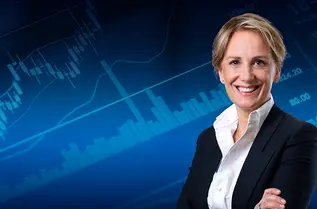Summary
Bonds (and cash) definitely back on the radar screen
The disconnect within the growth and inflation mix and the market hope for the Fed to quickly turn to an easing stance call for a prudent stance on risky assets and further favours bonds and cash.
Over the last month, markets lacked a clear direction owing to US banking sector stress, uncertainty regarding the US debt ceiling, and signs of economic deceleration amid tightening of credit conditions. However, a key factor supported markets in the form of Q1 earnings, which came in better than expected in the US. The Fed’s pause in its sharp rate hike cycle was also supportive.
Now, markets are pricing in a rosy scenario in which economic deceleration will force the Fed to cut rates in 2023, but we believe the Fed will stay on hold for 2023 and cut rates only in 2024. Four themes reinforce our cautious stance in this environment:
- Inflation is cooling slowly, and some signs of inflation psychology are showing up, as highlighted in the chart below. Given uncertainty regarding inflation expectations, the likelihood that Fed will cut rates any time soon is low.
- The US economy is cooling down. GDP is expected to start slowing substantially in Q2, with a contraction seen in 2H23. The resilience of the US consumer is the key variable to watch.
- China reopening is playing out, but the road is bumpy. The rebound is tilted towards internal demand, while the manufacturing side is weak and uncertainty on housing figures has increased.
- Markets are too complacent and are ignoring the wall of risks. There are signs of a gaps between fundamentals and excessive valuations in many areas, such as US equities and HY.
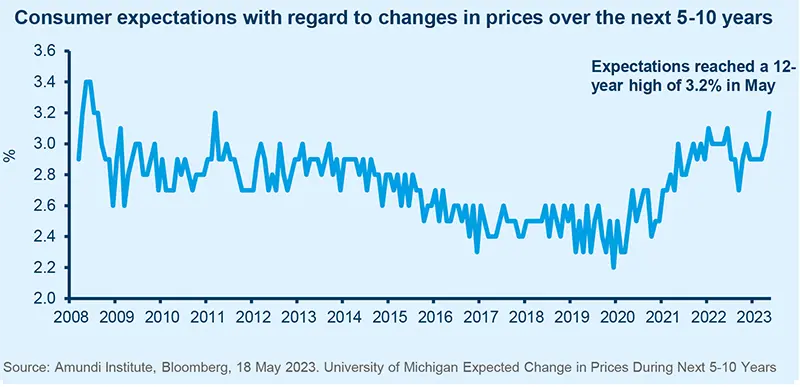
We think investors should adjust their cautious allocation as follows:
- Cross asset – We remain concerned about future profits, which leads us to stay defensive on equities and credit. We are positive on US duration, and we have upgraded cash on potential liquidity concerns in the markets. Further, we are now becoming more constructive on EM debt. Here, sentiment is improving as central banks have been ahead of the curve in hiking rates (especially in LatAm) and controlling inflation. A potential Fed pause would also be positive, but we are mindful of liquidity risks. Investors should consider strengthening hedges on equities and maintain a slightly positive view on gold.
- Fixed income – The balance is tipping towards a weak economic outlook in the US. Therefore, we stay constructive on US duration and expect the US yield curve to steepen. From a global perspective, we remain more cautious on duration in core Europe, Japan, Canada and the UK. With an overall cautious stance on credit, we believe investors should continue to favour investment grade, with attention to the evolution in corporate fundamentals. We remain defensive on high yield. Here, spreads are tight, considering our concerns on decelerating economic growth and tightening lending standards in Europe and the US. Declining profits could further affect companies’ abilities to access capital markets.
- Equities – Analysts’ earnings estimates are not incorporating the risk of an economic recession yet. We are defensive on the US ⎼ in particular on large mega cap and growth names. Market concentration is getting extreme, with a huge gap between performances of mega caps and small caps. Furthermore, once the issue of the debt ceiling is resolved, we think a potentially high issuance of USTs would drain liquidity from the system. In Europe, while the region is benefitting from declining energy costs and China reopening, equities would be weighed on by slowing growth. From a style view, we are positive on value and quality.
- EM assets – Slowing rate hikes by DM central banks and a weakening dollar support the case for LC debt. In equities, the mood is constructive on Brazil and China, but with a selective approach. Recent housing data in China pointed to an uncertain situation.
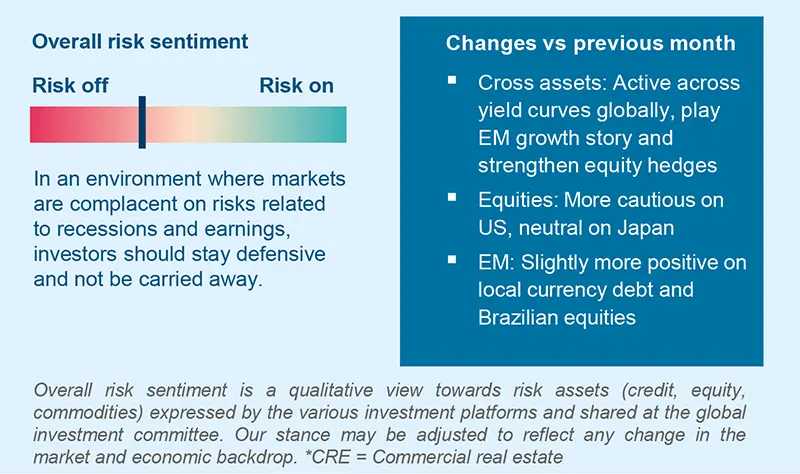
Three hot questions
|
Monica DEFEND |
We think the Fed hit the peak for the fed funds rate in the current cycle with its latest hike delivered in May.
1| Are central bank peak rates in sight? What next?
We think the Fed has hit its peak funds rate in the current cycle with its hike in May and rates up to 5.25%. There might be potential upward revisions as the bank will be ‘data-dependent.’ However, the ECB stressed that it is not pausing and that more ground needs to be covered. We expect the bank to raise rates to 3.5%. On the Bank of Japan, our conviction on the yield curve control policy changes has declined after the latest dovish surprise.
Investment consequences
-
Constructive on US duration yield curve bull steepening expected
-
Marginally cautious on Europe duration and neutral on peripherals
2| US debt ceiling: what to expect next?
The debt ceiling was hit on 19 January and the Treasury could run out of cash in early June. To avoid a default, they might enter into ‘debt prioritisation’ so that interest payments continue, but expenditure could be cut: essentials such as social services payments are likely to continue. Nonetheless, a failure to raise the ceiling would push the economy into recession. The risk that the Treasury would be unable to meet interest payments would increase the default risk. We foresee a last-minute agreement as politicians from both sides could come under public pressure. In any case, a period of market volatility is likely.
Investment consequences
-
A downgrade could disrupt money markets, leading to liquidity tightening.
-
As per Fed, a one-month impasse with Treasury meeting all payments could cause an 80bp rise in 10Y yields, a 30% fall in stocks, a 10% fall in dollar.
3| What are your takeaways from the Q1 reporting season so far?
The Q1 reporting season has surprised on the upside so far. In the US, the final average EPS figure should be around -0.7% (in Q4, it was -3.2%), with 84% of companies having reported. This is much better than it was expected in early April (-5.2%). However, in Europe, only 42% of companies have already reported. The 1Q23 blended EPS growth is on its way to printing another positive reading (+2.0%), even if it is lower than that expected in April.
Investment consequences
-
Continued cautious stance on US.
-
Quality is our first choice in the US and Eurozone, along with value, which is a long-term play.
-
In Japan, we prefer value.
More protection in equities and focus on EM assets
|
Francesco SANDRINI |
John O'TOOLE |
We stay defensive and are exploring the EM lever to enhance diversification and returns, given the growing EM-DM growth gap.
Economic growth is likely to remain on a downward trend, owing to the lagged effects of monetary tightening and slowing consumption patterns in the US and Europe. This would have obvious impacts on corporate earnings, but current risk asset valuations, particularly in equities, do not reflect these concerns. Hence, we maintain our defensive stance and explore opportunities less correlated with DM for a better diversification through EM. We also stay active on yield curves across geographies. However, this must be balanced by enhancing portfolio safeguards and remaining diversified.
High conviction ideas
We stay cautious on DM equities (US, Europe, Japan) amid falling margins and rich valuations. While US companies would be negatively affected by weak consumer spending, Europe is benefitting from the decline in energy costs. But, this is not sufficient to turn us positive on Europe. China, on the other hand, remains cheap vs other EM, and we remain positive.
We are positive on US duration amid recession risks and continue to believe in a steepening of the US yield curve. At the same time, we are cautious on JGB. Asynchrony in CB actions given growth and inflation outlooks offer opportunities for active management in fixed income.
For example, we now see tactical opportunities on the UK/Australian curves, wherein we favour 10Y UK over Australia. The BoE is getting closer to the end of its rate hiking cycle whereas the RBA has projected a hawkish bias. In EM, peaking inflation and the Fed moving close to a pause are improving sentiment. Thus, we are now slightly positive on a basket of EM bonds (attractive carry, high rates).
In an overall negative environment for HY credit, we maintain our defensive stance on the US, due to a mismatch between a decelerating economy and valuations. While liquidity currently is not an issue, declining profits could aggravate the credit squeeze if financial conditions remain tight.
Geopolitics was a key topic in FX this month, as we saw potential risks relating to South Africa’s relationship with Russia, a deteriorating political environment, and energy shortages. We are no longer positive on the ZAR/USD. On the other hand, the MXN/EUR and BRL/USD keep our interest as both offer high carry. In DM, global risks lead us to remain constructive on the JPY vs the CHF and the EUR. In contrast, the GBP should weaken against the EUR and the CHF.
Risks and hedging
We see risks for global growth and thus believe there is scope to enhance hedges on equities. Further, precious metals such as gold offer diversification and protection against a geopolitical crisis, although we acknowledge that the upside potential is limited due to slightly stretched valuations.
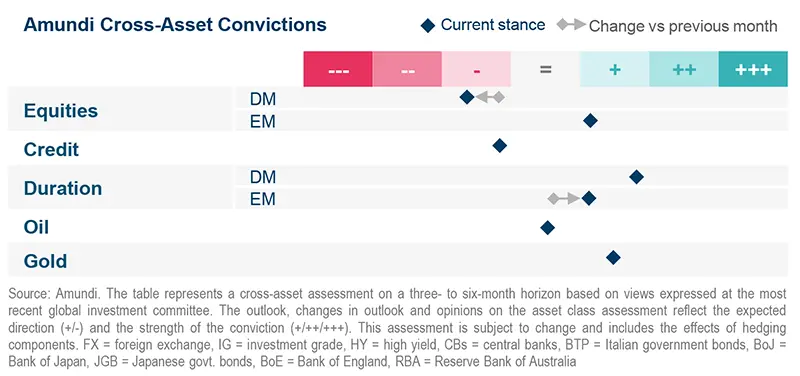
Resilience through quality in bonds
| Amaury D'ORSAY Head of Fixed Income |
Yerlan SYZDYKOV Global Head of Emerging Markets |
Kenneth J. TAUBES CIO of US Investment Management |
Tightening lending standards could affect the ability of low-rated issuers to borrow, exacerbating the liquidity crunch for them.
Overall assessment
Markets are rooting for a goldilocks scenario where inflation will quickly fall and slowing growth will have a limited impact on margins. However, we believe earnings could be under pressure at a time when credit conditions may tighten. Investors should explore quality in IG, EM and select government bonds.
Global and European fixed income
Inflation remains persistent in Europe and controlling it remains the ECB’s priority. This, coupled with our views of no recession in Europe, allows us to be slightly cautious on duration, but we are exploring when investors should move to neutral in Europe. We are also slightly defensive on Japan, Canada and the UK. However, on the US and euro peripheral debt, we are neutral. We increasingly believe in yield curve steepening in the US, Europe and Canada. With volatility still high, we prefer quality in credit and names with robust cash flow potential. Thus, we stay slightly constructive through EUR IG and the UK: in particular, we like subordinated financials in Europe and prefer IG over HY. On the latter, we are concerned about liquidity issues and, where possible, we believe HY exposure should be hedged.
US fixed income
The Fed looks set to pause its tightening cycle, but it will follow a data-dependent approach. This ambiguity, along with recession and financial stability risks, creates uncertainty, leading us to be agile. We are positive on duration but prefer the intermediate part of the US Treasury curve. In general, banks are becoming concerned about the quality of their lending and this creates implications for liquidity for companies, particularly the low-quality ones. Thus, we stay selective and prefer those names that are higher up in credit quality, i.e., IG over HY. Select regional banks and real estate investment trusts could present an interesting case. In agency MBS, we are vigilant on the demand-supply dynamics as banks may liquidate to respond to their funding requirements in the present context, leading to pressure on agency spreads.
EM bonds
Robust growth supports a positive view, but risks related to geopolitical tensions and country-specific factors keep us selective. HC offers appealing carry, and we focus on HY there. We also have a constructive view on EM FX and LC. On the latter, we like Mexico due to ‘nearshoring’, but are assessing how signs of some weakness in China could affect commodities exporters. Finally, there are selective opportunities in EM corporates with strong governance and cash flows.
FX
Lower rates and concerns about a US slowdown are likely to weigh on the dollar. But on EM FX, such as the MXN, we are positive, owing to carry. To balance this, investors should look towards the JPY and CHF to maintain safeguards.
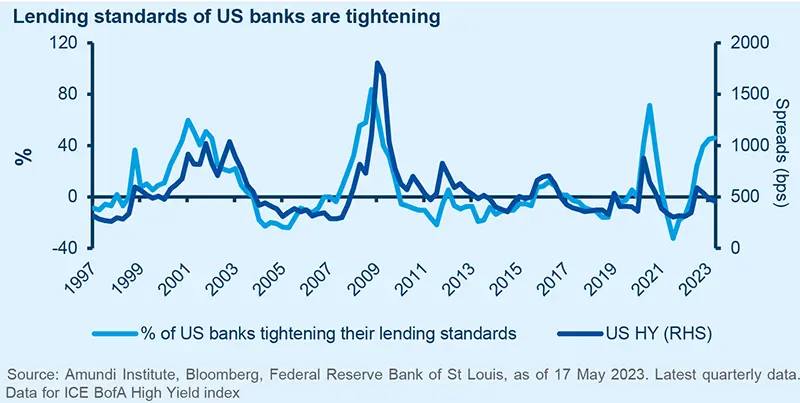
Look at quality of balance sheets and valuations
| Fabio DI GIANSANTE Head of Large Cap Equity |
Yerlan SYZDYKOV Global Head of Emerging Markets |
Kenneth J. TAUBES CIO of US Investment Management |
Looking at the stability of a business model without considering valuations could be a big mistake in the current context.
Overall assessment
Corporate earnings and consumption are key variables we are monitoring. While on the US consumption front, we see signs of cracks in the high-income bracket, corporate reserves are robust for now. Eventually, the latter could be affected because raising prices without affecting sales volumes will not be possible. At that stage, corporate profits would be affected. Thus, we prioritise balance sheet strength/valuations in the quality, value and EM areas.
European equities
We see margins holding up in selected sectors and scope for the region to benefit from its external trade relations, but we are careful on how much of China reopening is already priced in. Thus, we stay balanced because any correction could affect expensive areas (i.e., cyclical growth). We favour attractively priced defensive names in staples and quality stocks in cyclical (industrials) sectors. Within these, pricing power is important for us, as inflation is persistent, and businesses are struggling to absorb rising costs through an impact on margins. We also see value in mid-caps and value but are assessing their earnings potential at a time of slowing growth. On the other hand, we are cautious on technology and consumer discretionary.
US equities
As policy drag kicks in, it could translate into layoffs and weakening consumption patterns. However, markets are not concerned about this, and volatility has been low. This resiliency has been driven by mega cap and growth names, where we think valuations are excessive. Interestingly, these valuations are high at a time of very high profit margins, which could be hurt if anything goes wrong on the consumption front. So, we stay selective and like defensive names but not just the traditional ones. For instance, we like healthcare equipment (medical technology) with attractive prices. On the other hand, we see that some cyclical names are cheap, whereas those with strong business models are expensive. We aim to achieve a balance there. However, we are cautious on technology and semiconductor businesses. We are also assessing the effect on market liquidity from any potential deal on raising the US debt ceiling.
EM equities
Slowing growth in the DM world is occurring at a time of improving growth prospects for EM. While this keeps us positive on the region and on Asia (China, Indonesia), we acknowledge that China could witness an uneven pace of recovery. Elsewhere, in Latin America, we slightly raised our conviction on Brazil but continue to monitor the fiscal reform path. At a sector level, we like discretionary and real estate, and prefer value to growth. However, we are cautious on healthcare and tech semiconductors.
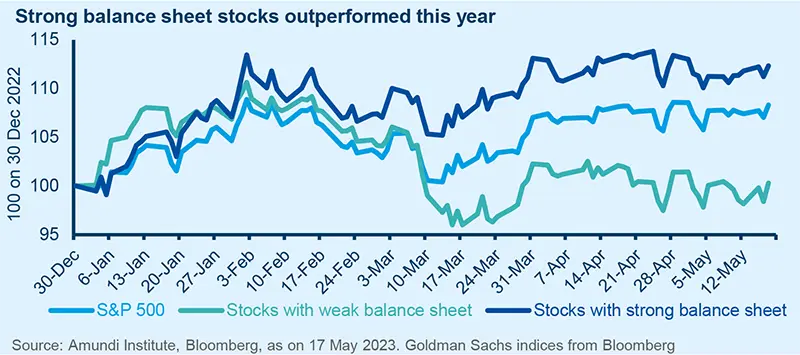
Amundi asset class views
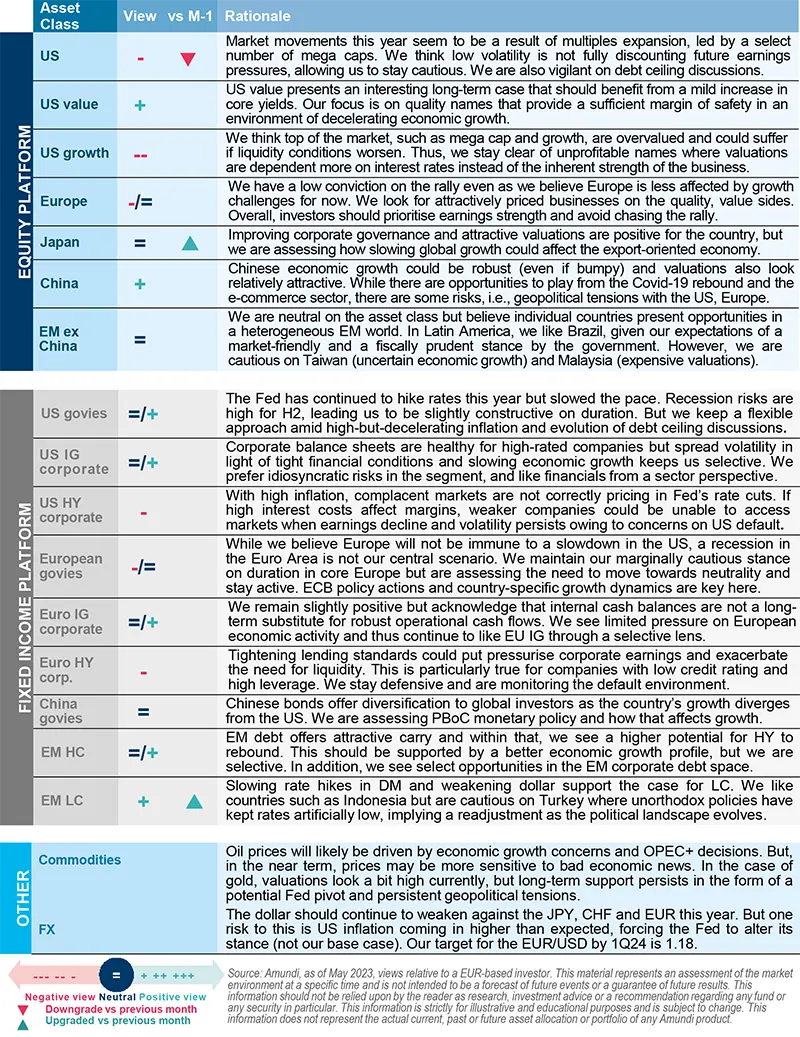
Definitions & Abbreviations
- ADR: A security that represents shares of non-US companies that are held by a US depositary bank outside the US. They allow US investors to invest in non-US companies and give non-US companies access to US financial markets.
- Agency mortgage-backed security: Agency MBS are created by one of three agencies: Government National Mortgage Association, Federal National Mortgage and Federal Home Loan Mortgage Corp. Securities issued by any of these three agencies are referred to as agency MBS.
- Beta: Beta is a risk measure related to market volatility, with 1 being equal to market volatility and less than 1 being less volatile than the market.
- Breakeven inflation: The difference between the nominal yield on a fixed-rate investment and the real yield on an inflation-linked investment of similar maturity and credit quality.
- Carry: Carry is the return of holding a bond to maturity by earning yield versus holding cash. Core + is synonymous with ‘growth and income’ in the stock market and is associated with a low-to-moderate risk profile. Core strategy is synonymous with ‘income’ in the stock market.
- Correlation: The degree of association between two or more variables; in finance, it is the degree to which assets or asset class prices have moved in relation to each other. Correlation is expressed by a correlation coefficient that ranges from -1 (always move in opposite direction) through 0 (absolutely independent) to 1 (always move in the same direction).
- Credit spread: The differential between the yield on a credit bond and the Treasury yield. The option-adjusted spread is a measure of the spread adjusted to take into consideration the possible embedded options.
- Currency abbreviations: USD – US dollar, BRL – Brazilian real, JPY – Japanese yen, GBP – British pound sterling, EUR – Euro, CAD – Canadian dollar, SEK – Swedish krona, NOK – Norwegian krone, CHF – Swiss Franc, NZD – New Zealand dollar, AUD – Australian dollar, CNY – Chinese Renminbi, CLP – Chilean Peso, MXN – Mexican Peso, IDR – Indonesian Rupiah, RUB – Russian Ruble, ZAR – South African Rand, TRY – Turkish lira, KRW – South Korean Won, THB – Thai Baht, HUF – Hungarian Forint.
- Curve steepening: A steepening yield curve may be a result of long-term interest rates rising more than short-term interest rates or short-term rates dropping more than long-term rates. Bull steepening a change in the curve due to short-term rates falling faster than the long-term rates. This leads to a higher spread between the short and long term rates.
- Bull steepening: A change in the curve due to short-term rates falling faster than the long-term rates. This leads to a higher spread between the short and long term rates.
- Curve inversion: When long-term interest rates drop below short-term rates, indicating that investors are moving money away from short-term bonds.
- Cyclical vs. defensive sectors: Cyclical companies are companies whose profit and stock prices are highly correlated with economic fluctuations. Defensive stocks, on the contrary, are less correlated to economic cycles. MSCI GICS cyclical sectors are: consumer discretionary, financial, real estate, industrials, information technology and materials. Defensive sectors are: consumer staples, energy, healthcare, telecommunications services and utilities.
- Duration: A measure of the sensitivity of the price (the value of principal) of a fixed income investment to a change in interest rates, expressed as a number of years.
- High growth stocks: A high growth stock is anticipated to grow at a rate significantly above the average growth for the market.
- Liquidity: The capacity to buy or sell assets quickly enough to prevent or minimise a loss.
- P/E ratio: The price-to-earnings ratio (P/E ratio) is the ratio for valuing a company that measures its current share price relative to its per-share earnings (EPS).
- NBFI: A non banking financial institution provides select financial services but doesn’t have a full fledged banking license.
- Net interest margin: It is a measure that compares a bank’s interest income from lending with its interest expense on its liabilities (such as bank deposits), expressed as a percentage of its assets.
- QE: Quantitative easing (QE) is a type of monetary policy used by central banks to stimulate the economy by buying financial assets from commercial banks and other financial institutions.
- Quality investing: This means to capture the performance of quality growth stocks by identifying stocks with: 1) A high return on equity (ROE); 2) Stable year-over-year earnings growth; and 3) Low financial leverage.
- Quantitative tightening (QT): The opposite of QE, QT is a contractionary monetary policy aimed to decrease the liquidity in the economy. It simply means that a CB reduces the pace of reinvestment of proceeds from maturing government bonds. It also means that the CB may increase interest rates as a tool to curb money supply.
- Non-SIFI: A systemically important financial institution (SIFI) is an institution that the US Fed and regulators believe would pose a serious risk to the financial system and the economy if it collapses. A non-SIFI is an institution that doesn’t fall in this category.
- TIPS: A Treasury Inflation-Protected Security is a Treasury bond that is indexed to an inflationary gauge to protect investors from a decline in the purchasing power of their money.
- Value style: This refers to purchasing stocks at relatively low prices, as indicated by low price-to-earnings, price-to-book and price-to-sales ratios, and high dividend yields. Sectors with a dominance of value style: energy, financials, telecom, utilities, real estate.
- Volatility: A statistical measure of the dispersion of returns for a given security or market index. Usually, the higher the volatility, the riskier the security/market.
- Yield curve control: YCC involves targeting a longer-term interest rate by a central bank, then buying or selling as many bonds as necessary to hit that rate target.


